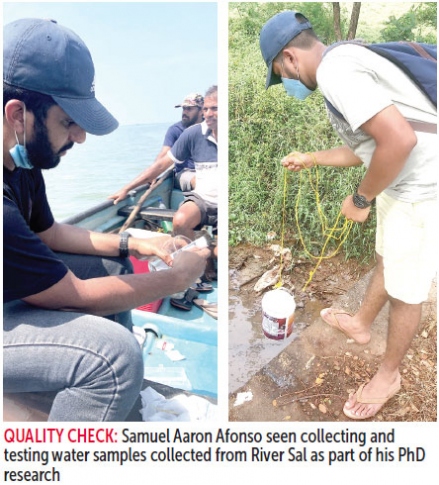
KARSTEN MIRANDA
MARGAO: A young Samuel Aaron Afonso from Carmona, earlier a geology student from Chowgule College, has mapped the complete decline of water levels in the River Sal, indicating that the lifeline of South Goa needs intensive care to have any chances of survival. This was a part of dissertation where he deep doves into the pollution in the river Sal.
But the scientific study was possible with the grassroots knowledge of fishermen who know the river like the back of their hands and are experiencing its demise
Afonso, did BSc in Geology from Chowgule College, was at that time, completing his MSc in Environment Science and Technology from BVIEER, Pune.
His dissertation titled ‘Socio-Economic Impact Assessment of Water Pollution: A Case Study on River Sal, Goa’, which was successfully submitted and accepted, threw up some shocking results.
Veteran fisherman Remedios Crasto from Assolna, accompanied Afonso who needed to travel across the actual River itself to collect scientific information and then analyse the data.
How the study was carried out
The study area of the river commenced by locating all discharge points, based on visual interprettion along with local knowledge on a small motorboat during the low tide, since it leads to better visibility of hidden pipes and drains.
The analysis showed decline of water quality at a number stretches of the river, which is caused due to direct solid waste disposal, along with industrial and residential sewage disposal.
The fallout of Sal’s pollution
The increase of solids directly influenced the increase in pH of the water leading to the decline of many fish species. The calcification process, which is critical for the formation of Clams, Mussels and Oysters, has also been adversely affected.
This decline has directly impacted the livelihood of fishermen and has forced them to explore alternate sources of income due to losses. The decline in water quality has made it unfit to be used in khazan lands corresponding to it, this has led to many khazans being abandoned and unused.
The root causes: Discharge from STPs, residential areas, hotels and fishing trawlers
“The pollution of the river Sal is caused by the discharge of various types of waste, such as Sewage Treatment Plants (STPs), industries, residential areas, hotels, prawn hatcheries, and fishing trawlers. Untreated sewage is released into the nallahs that lead to the river Sal due to seepage and overflow from poorly managed soak pits. The main reasons for this are the lack of policy implementation,” said Afonso.
